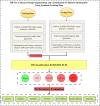DRSegNet: A cutting-edge approach to Diabetic Retinopathy segmentation and classification using parameter-aware Nature-Inspired optimization
- PMID: 39637079
- PMCID: PMC11620556
- DOI: 10.1371/journal.pone.0312016
DRSegNet: A cutting-edge approach to Diabetic Retinopathy segmentation and classification using parameter-aware Nature-Inspired optimization
Abstract
Diabetic retinopathy (DR) is a prominent reason of blindness globally, which is a diagnostically challenging disease owing to the intricate process of its development and the human eye's complexity, which consists of nearly forty connected components like the retina, iris, optic nerve, and so on. This study proposes a novel approach to the identification of DR employing methods such as synthetic data generation, K- Means Clustering-Based Binary Grey Wolf Optimizer (KCBGWO), and Fully Convolutional Encoder-Decoder Networks (FCEDN). This is achieved using Generative Adversarial Networks (GANs) to generate high-quality synthetic data and transfer learning for accurate feature extraction and classification, integrating these with Extreme Learning Machines (ELM). The substantial evaluation plan we have provided on the IDRiD dataset gives exceptional outcomes, where our proposed model gives 99.87% accuracy and 99.33% sensitivity, while its specificity is 99. 78%. This is why the outcomes of the presented study can be viewed as promising in terms of the further development of the proposed approach for DR diagnosis, as well as in creating a new reference point within the framework of medical image analysis and providing more effective and timely treatments.
Copyright: © 2024 Kamal et al. This is an open access article distributed under the terms of the Creative Commons Attribution License, which permits unrestricted use, distribution, and reproduction in any medium, provided the original author and source are credited.
Conflict of interest statement
The authors have declared that no competing interests exist.
Figures












Similar articles
-
A novel fusion of genetic grey wolf optimization and kernel extreme learning machines for precise diabetic eye disease classification.PLoS One. 2024 May 20;19(5):e0303094. doi: 10.1371/journal.pone.0303094. eCollection 2024. PLoS One. 2024. PMID: 38768222 Free PMC article.
-
Gray wolf optimization-extreme learning machine approach for diabetic retinopathy detection.Front Public Health. 2022 Aug 1;10:925901. doi: 10.3389/fpubh.2022.925901. eCollection 2022. Front Public Health. 2022. PMID: 35979449 Free PMC article.
-
Latent space autoencoder generative adversarial model for retinal image synthesis and vessel segmentation.BMC Med Imaging. 2025 May 5;25(1):149. doi: 10.1186/s12880-025-01694-1. BMC Med Imaging. 2025. PMID: 40325399 Free PMC article.
-
Comparison review of image classification techniques for early diagnosis of diabetic retinopathy.Biomed Phys Eng Express. 2024 Sep 5;10(6). doi: 10.1088/2057-1976/ad7267. Biomed Phys Eng Express. 2024. PMID: 39173657 Review.
-
Diabetic retinopathy screening through artificial intelligence algorithms: A systematic review.Surv Ophthalmol. 2024 Sep-Oct;69(5):707-721. doi: 10.1016/j.survophthal.2024.05.008. Epub 2024 Jun 15. Surv Ophthalmol. 2024. PMID: 38885761
References
MeSH terms
LinkOut - more resources
Full Text Sources
Medical

